Have you seen a red eye bird? If so, you’re lucky! Such red-colored bird eyes are rare and are less widely distributed around the world.
What kind of birds have red eyes?
These are some of the birds with the red eyes:
- Asian Glossy Starling
- White-Winged Dove
- Black-Crowned Night Heron
- Roseate Spoonbill
- Black-capped lory
- Killdeer
- Red Eyed Dove
- Wood Duck
- Horned Grebe
- Spotted Towhee
- Black Swan
- Rainbow Lorikeet
- Black Necked Slilt
Table of Contents
Birds with Red Eyes
1.Asian Glossy Starling (Aplonis panayensis)
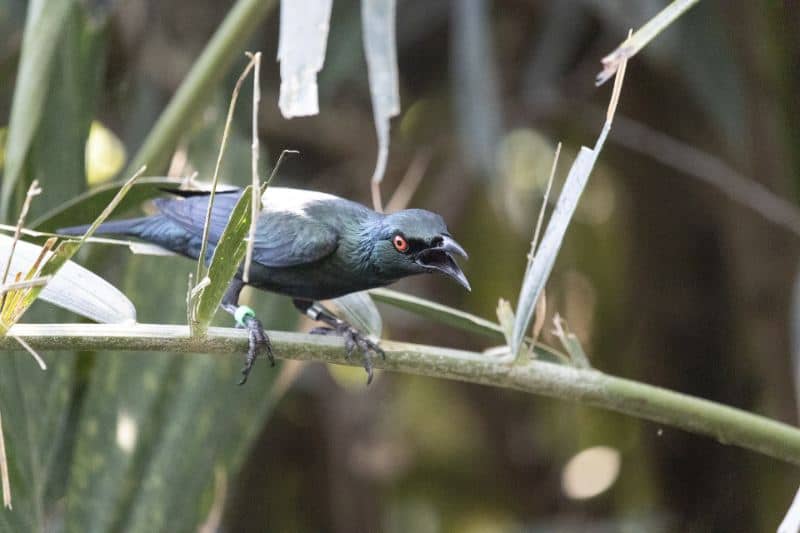
The Asian glossy starling is a type of starling in the family Sturnidae that is found in the Philippines, Bangladesh, Brunei, Indonesia, Malaysia, Singapore, Myanmar, Taiwan, and Thailand. Habitat: Their common habitats are subtropical or tropical moist forest and mangrove forest.
Identification: They are Identified by black-colored feet, bills, glossy feathered body with red eyes, all of which make it look like a robot bird. Both the sexes male and female are similar in appearance. Whose biometrics are 20 cm in length and 60 g in weight.
Food: They are frugivorous and insectivorous birds that feed on a variety of fruits such as figs, papaya, banana, mango, berries, nuts, insects, grasshoppers, beetles, larvae, caterpillars, crickets, spiders, and snails.
Other Facts: The Asian Glossy Starling is mostly monogamous and found in colonies of about 20 birds therefore they are considered as the colonial breeder. It uses cavities as a nest, these cavities include old woodpecker holes in a tree, or even in a nest-box, where 3 bluish eggs with dark markings are laid.
2.White-Winged Dove (Zenaida asiatica)
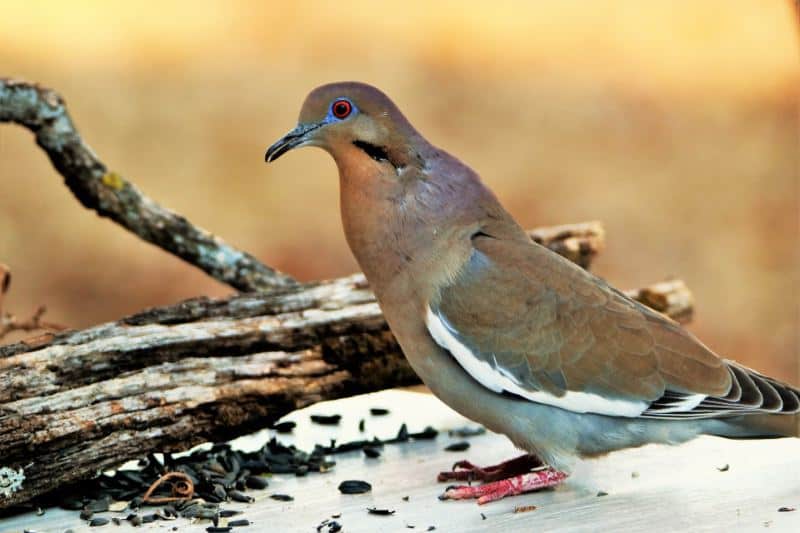
The white-winged dove is a dove found in Mexico, Central America, parts of Canada, Puerto Rico, and the Caribbean. Habitat: The Asian Glossy Starling habitats are river woods, mesquites, saguaros, brushlands in Texas, oak woods, farmland, suburbs, citrus groves, and groves.
Identification: The biometrics of the White-winged dove is 150 g in mass, 30 cm in length, and 25 years of lifespan in captivity whereas up to 15 years in the wild. Compared to doves, white-winged doves are quite large in size, with white edges on their wings, blue eyes, and red eyes. The cheeks have a dark line and brown to the rusty color body.
Food: White-winged doves feed on seeds of desert willow trees, cactus fruit called saguaro, organ-pipe, ocotillo, agave, and other cacti.
Other Facts: A female dove uses a cactus clump or a tree branch to build a nest while still using sticks provided by the male bird. However, they reuse the nest built by itself in the previous year or left by other birds.
The interesting thing about them is that, they fly 35 km in search of water. However, when their habitat is a desert or moving through the desert, they are known to obtain the necessary moisture from saguaro cactus fruit.
Thus, they are known to disperse the saguaro cactus seeds, especially in the desert which is a biological importance of White-winged doves. While migrating, there are about 4000 white-winged doves in a flock flying together especially when it’s time to return to their nests.
3.Black-Crowned Night Heron (Nycticorax nycticorax)

The black-crowned night heron, or black-capped night heron, or night heron is a type of heron distributed across the world. Habitat: The Black-crowned night heron habitats are mainly the aquatic habitats that are both fresh and saltwater such as marshes, rivers, ponds, mangrove swamps, tidal flats, farms, rice fields.
Identification: The Black-crowned night heron identified by black color back, white belly, white or yellow face, red eyes, yellow color legs, and long white plumages on the back of their head. Its biometrics are 800 g in weight, 28 inches in length, 55kmph in speed, and has 20 years of lifespan.
Food: The Black-crowned night heron feeds on fishes, krill, crustaceans, frogs, crab, insects, small mammals, bugs, small birds, and small vertebrates. They are also opportunistic feeders on carrion.
Other Facts: Black-crowned Night Herons are named so because they hunt from night until early morning and rest throughout the day, and its scientific name Nycticorax means “Night Raven”. One of the interesting facts about them is they take care of other bird chicks when placed in the nests of these Black-crowned Night Herons
4.Roseate Spoonbill (Platalea ajaja)
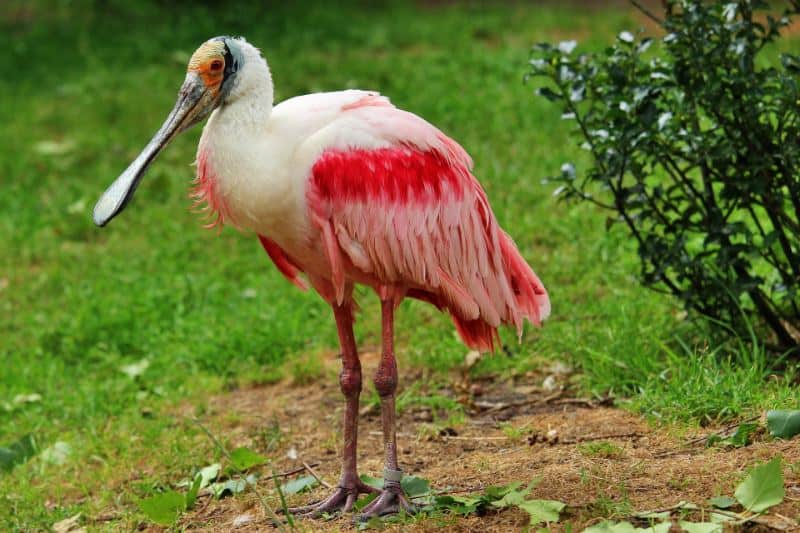
The roseate spoonbill is a type of wading bird that is also a large wading bird that belongs to the family Threskiornithidae. Habitat: Their habitats includeshallows of freshwater, brackish water, marine waters, bays, mangroves, and forested swamps.
Identification: These are identified by their biometrics such as 1 kg in weight, 85 cm in length, 135 cm in wingspan, and has a lifespan of 10 years.
Food: They are usually found to feed on small fish, shrimp, mollusks, snails, and insects. However, the pink color in it is due to their special diet on the crustacean.
Other Facts: They are social birds as they feed together with other spoonbills and sometimes also with other wading birds. They are known to live and fly together as well.
The bill of the chicks is not the same as in the adults, but the bills often tend to form as a spoon shape with the development of the chicks. These are the only spoonbills that have the pink plumage out of six types of spoonbill in the world. However, The beaks present in the chicks of spoonbills are straight that change to spoon shape with the development of the chick.
5.Black-capped lory (Lorius lory)
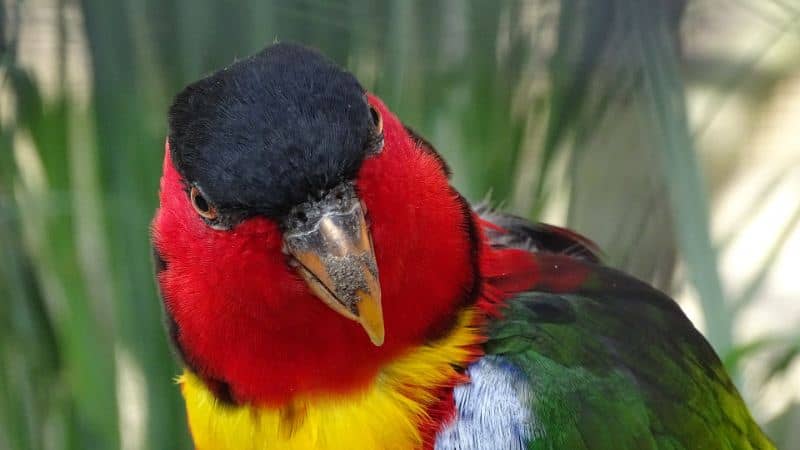
The black-capped lory or western black-capped lory or the tricolored lory is a type of parrot found in New Guinea and nearby islands. Habitat: Its habitats are forest, and forest edges.
Identification: These are identified by their biometrics such as 180-250 g in weight, 12 inches in length, and 25 years of lifespan. They have small, round tails, unique curved beaks, greenish wings, dark blue feathers on the lower parts, and black streaks around the eyes.
These birds have a variety of colors with bright red eyes, black color is special to them on top of their head, so they are called Black-Capped Lory, and when taken as pets, they need a wide area.
Food: They feed on fruit, nectar, seed, flowers, pollen and insects, and mealworms.
Other Facts: The black-capped lory builds its nests in tree holes that are 20-25 m above the ground level. Where it lays 1-2 white eggs that need 23-25 days of incubation, it takes 4 years to attain maturity when they hatch. These are found in pairs and also in flocks of 10 or more birds. These are smart birds that can dance according to the music, play with the kid and owner, so as part of the exercise.
6.Killdeer (Charadrius vociferus)

The killdeer are birds that are found in the Americas, Canada, which include three subspecies and it belongs to the charadriidae family. Habitat: The habitat of Killdeer are sandbars, mudflats, grazed fields, lawns, parks, and golf courses.
Identification: The Killdeer is identified by dark-colored bill, brown back, white belly, white-collar, long legs and long wings with white stripes, slender wings. Males are larger than female killdeers. Its biometrics are 88-120 gm in weight, 28 cm in length, 48 cm in wingspan, and 11 years in lifespan.
Food: They feed on mainly Insects, grasshoppers, earthworms, fly larvae, spiders, worms, snails, beetles, caterpillars, crayfish, and less on weed seeds.
Other Facts: The Killdeer shows the broken-wing act to ward-off the intruders away from nests and chicks. When building a nest both males and females engage in nest building tasks. The eggs laid by the killdeer efficiently camouflages with the background.
Killdeers are efficient swimmers, where adults can swim in fast-flowing water while the chick in small streams. The name “killdeer” refers to “kill-deer” calls which this species often produces. “Kill-deer” calls are especially frequent during the courtship.
7.Red-eyed Dove (Streptopelia semitorquata)

The red-eyed dove is a dove usually found in Sub-Saharan Africa and wild Africa. Habitat: The Habitats of Red-eyed doves are woodland, mangroves, farms, bulblets, plantations, semi-urban parks, and gardens.
Identification: They are identified by red eyes, ringneck, greyish-brown upperparts, a patch of skin surrounding the red-eye. Sexes of these birds are similar in appearance. Its biometrics are 180 g in weight, 12 inches in length.
Food: They feed on grass seeds, maize, sunflower, castor seed, millet, nutgrass, berries, termites, and millipede.
Other Facts: These birds are usually seen alone near the forest rivers. This can build nests using sticks from trees, where the females can lay two eggs that are white to cream.
8.Wood Duck (Aix sponsa)

The wood duck or dabbling duck or Carolina duck or Swamp Duck, or Squealer Duck or Summer Duck is a type of duck that is the most colorful waterfowl found in North America. Habitat: Habitats of wood ducks are ponds, lakes, marshes, sides, and along the rivers and streams. However, they prefer mixed habitats of water and forests or dry and wetland.
Identification: These are identified by their biometrics which includes 450 gm in weight, 55 cm in length, and have 4-15 years of lifespan.
Food: They feed on the seeds, fruits, insects, arthropods, acorns, nuts, small invertebrates, grain, and aquatic vegetables as well. They also eat other aquatic vegetations such as algae, leaves and aquatic plants and roots.
Other Facts: The female wood ducks lay up to 14 eggs that require up to 37 days of incubation. The young ducklings grow fast after hatching and learn to fly within 10 weeks of the hatching date. The adult male duck is referred to as a Drake, a female duck is referred as Hen, while the duck chick is referred as a duckling.
The ducklings are fast learners and often grow quickly, although they can jump from altitudes of 250 ft without getting any injury, and like to play with flowing water streams along with swimming.
9.Horned Grebe (Podiceps Auritus)
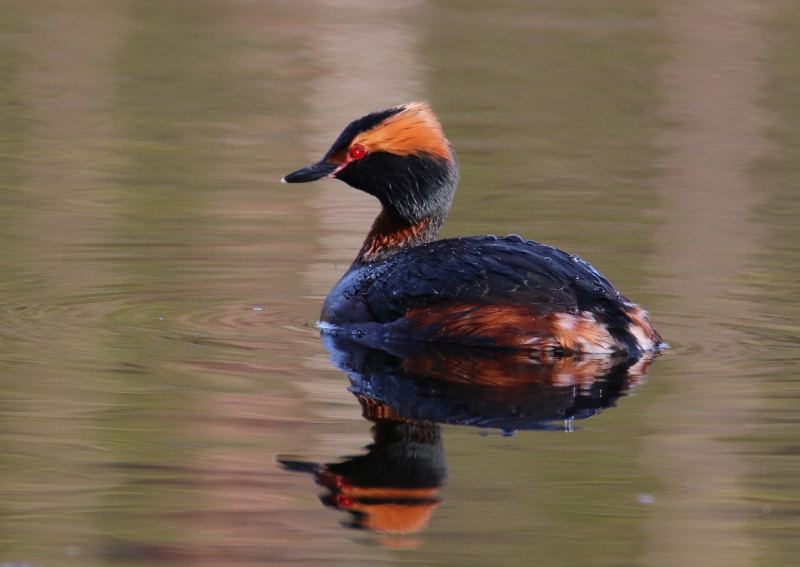
The horned grebe or Slavonian grebe is a waterbird in the family Podicipedidae, and found in North America during breeding. Habitat: The habitats of Horned Grebes are parklands, boreal, subarctic regions, shallow freshwater ponds, and marshes.
Identification: Whose biometrics includes a weight of 570 gm, length of 39 cm with a lifespan of 5-6 years. These have dark gray color back, white ventral surface, black head with white cheek.
Food: They feed on insects, crustaceans, fish, tadpoles, leeches, salamanders, small parts of vegetation, and mollusks.
Other Facts: The horned grebe Males and female birds both take part in incubation while also supporting each other by finding and offering the prey for the partner who is engaged in the incubation task and also defending the nest from intruders.
10. Spotted Towhee (Pipilo maculatus)

The spotted towhee is the large New World sparrow that belongs to the Passerellidae family. Habitat: The habitats of the Spotted towhee are open woods, undergrowth, mountain manzanita thickets, scrub oaks, or pinyon-juniper woods, and brushy edges, and mountain slopes.
Identification: The spotted towhee identified easily by the presence of red eyes, thick beak, pink legs, fan-shaped long tail, the upper part of the black plumage of male birds, white striped wings, whereas the females have a dark grey-brown body. Its biometrics include 40 gm weight, 8 inches long, and a wingspan of 11 inches. These can be identified by their singing that is most of the early time is spent in singing by the male Spotted towhees to attract the mates.
Food: The spotted towhee feeds on the beetles, ladybugs, darkling beetles, click beetles, wood-boring beetles, crickets, grasshoppers, caterpillars, moths, bees, wasps, millipedes, sowbugs, spiders, nightshade, berries, seeds, thistle, raspberry, blackberry, poison oak, sumac, acorn, chickweed, and crops such as oats, buckwheat, corn, and cherries.
Other Facts: These are intelligent birds as they use morning dew from the leaves of the plants to wash when there is a scarcity of water, and opens and spreads their wings while resting on the grass during hot climates.
During reproduction female lays about 4 eggs of either creamy white or greenish colored having red or brown spots which require 12 days of incubation to hatch while the male birds supply the food for incubating female birds until the eggs hatch.
11.Black Swan (Cygnus atratus)
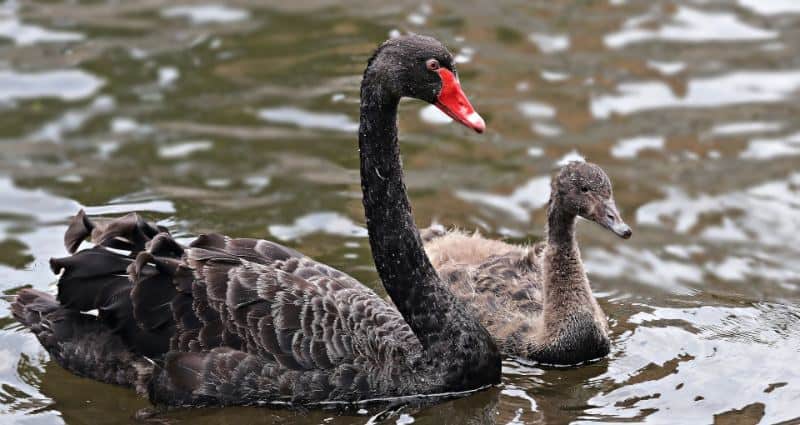
The black swan is a large waterbird, that are found in the southeast and southwest regions of Australia. Habitat: Their habitat includes freshwater, brackish water, salt water lakes, estuaries, swamps, and rivers.
Identification: They are easily identified by their black plumage and orange-red bill. These weights about 9 Kg and belong to the Anatidae family.
Food: They feed on plant and vegetation that includes aquatic vegetation, leaves, flowers, algae, and weeds.
Other Facts: Black swans are aggressive to the other water birds or waterfowls because these black swans are territorial, especially in water habitats, thus they avoid other water birds and waterfowl birds to come in contact with the water.
12.Rainbow Lorikeet (Trichoglossus moluccanus)

The rainbow lorikeet is a species of parrot that is found in Australia, eastern seaboard. Habitat: Its habitat includes rain forest, coastal bush and woodland areas.
Identification: They are identified by having colorful body feathers, bright red beak, blue head, green color wings, tails, back, and orange breast.
Food: They feed on pollen, nectar, from grevilleas, callistemon, banksias, artificial nectar, fresh fruit, apples, pears, strawberries, grapes, melon, peaches and cherries and insects.
Other Facts: They lay their eggs in decayed woods, that is in usually an eucalypt tree. Both participate in building nests and also in feeding their eggs. During breeding they are aggressive and can become territorial by avoiding other birds to build nests, if so they will try to remove nests by pulling the other birds chicks from nests.
Read more : Eagle Vs Hawk ?
13.Black-necked stilt (Himantopus mexicanus)
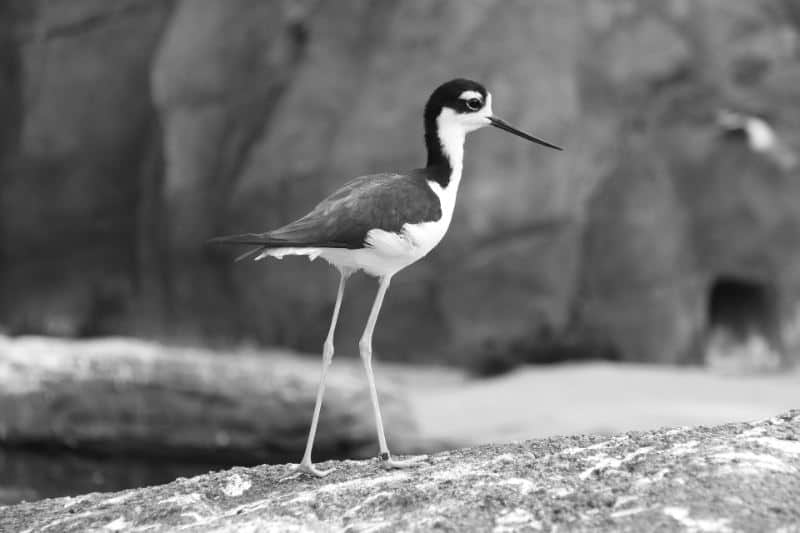
This shorebird has long legs that are slender like and are distributed across the American wetlands and coastlines.
Habitat: Its habitats include shallow wetlands, salt ponds, flooded areas of rivers, shallow lagoons, saltmarshes, mangrove swamps, mudflats, Sewage ponds, evaporation ponds, rice fields, and flooded agricultural fields.
Identification: The height and weight are around 14 to 17 inches and 190 gm respectively with a diverse food in its diets. The ventral body has white color feathers and dorsal has black colored feathers with red colored long legs and has records of lifespan of up to 20 years.
Food: They feed on insects, beetles, flies, shrimps, snails, and aquatic plants too. These birds have an ideal body meant for wading in shallow waters while prey for food at seashore and rivers as well.
Other Fact: Did you know both male and female birds of Black-necked stilt participate during the incubation period.

